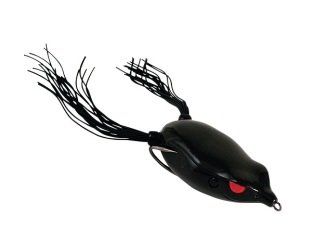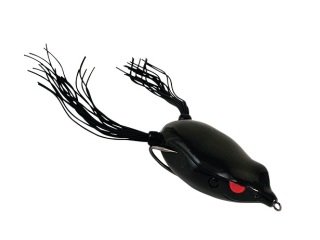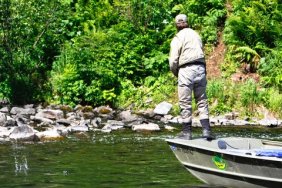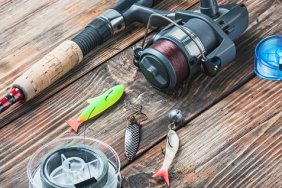
Topwater frogs and toads are two of the most popular lures for bass and there are two main reasons why: they’re extremely effective and they’re exciting to use. While the lily pads and thick grass can cause some anglers to cringe in fear, smart fishermen know that such vegetation conceals trophy fish. Knowing how to utilize your topwater frogs and toads to catch these fish, however, takes some practice and patience, but will provide some of the most exciting strikes and fights you’ll ever experience.
Inexperienced readers may be asking, “What’s the difference?” Well, there are numerous properties, physical traits, and uses that distinguish the two baits from each other. Frogs, for example, float on the water’s surface, and are plastic, hollow-bodied lures equipped with a double hook that bends into the bait’s back to make it weedless. They also possess legs made up a rubber skirt material which flares and pulses in the water. The Snag Proof, Spro, and Bass Pro Shops Kermie are all examples of frog baits, and are all proven lures in the weeds and lily pads.
Frogs cast a mile and, if fished from the boat towards shore, can be tossed onto a shoreline and worked slowly through the weeds without snagging. They also come in many patterns–companies such as Spro, for instance, offer frogs in dozens of colors and sizes for any situation—but don’t get overwhelmed; the fish can only see the bottom of the frog so the patterns on top don’t make a difference. As with spinnerbaits, I always suggest picking up a black, white, and maybe a green color, to accommodate different conditions. Throw the white frog when it’s sunny, the black when it’s cloudy and the water’s murky, and the green when they’re not hitting the first two colors.
Toads are soft plastic and come in pouches of about half a dozen per pouch usually. Examples of great toads include Strike King’s Rage Toad, Yum’s Money Toad, and Gambler’s Cane Toad. They don’t float and must be worked just like a buzzbait, so that their legs will kick up a wake on the retrieve. They don’t come rigged and you’ll need to Texas-rig them with 3/0, 4/0, or 5/0 wide gap hooks. Zoom offers hooks with a corkscrew attached to the eyelet that you can screw into the toad’s head for both extra strength and ease when rigging. Make sure the hook is aligned straight, as it will act as a rudder on the retrieve.
Work these lures by retrieving them steadily over thick weeds and hopping them across lily pads, stopping when you hit a pocket to let it sink a bit. Bass hidden in thick cover will strike when aggressive and even if a strike doesn’t end in a hook set, stop the toad and allow it to sink, as this will often trigger a second strike. If this doesn’t work, reel in your line and cast back past the strike location. If you’re getting a lot of missed strikes, slow down your retrieve a bit. Always wait until you lose sight of your bait on the strike or feel the weight of a fish on your line before setting the hook. You want to make sure the fish has it before you yank it out of the weeds. Also, be sure to use heavy line, a heavy action rod, and a reel with a high gear ratio when fishing frogs and toads. You’ll be fishing tough lily pads and weeds, not to mention fighting a fish among such cover, so you’ll need heavy-duty gear to hold your own and still pull the fish to the boat.
In the heat of summer, you can find hidden caches of trophy fish congregating beneath the cool shade of weeds and lily pads. Don’t be afraid to intrude on them and send a frog or toad their way. There are days when frogs will work better than toads, and vice versa, so be patient and experiment with retrieval speed, lure color, and lure of choice. Keep one or two of each in your tackle box, because once you find a good collection of vegetation and that first big fish explodes at the surface, you’ll be thankful that you picked them up.








